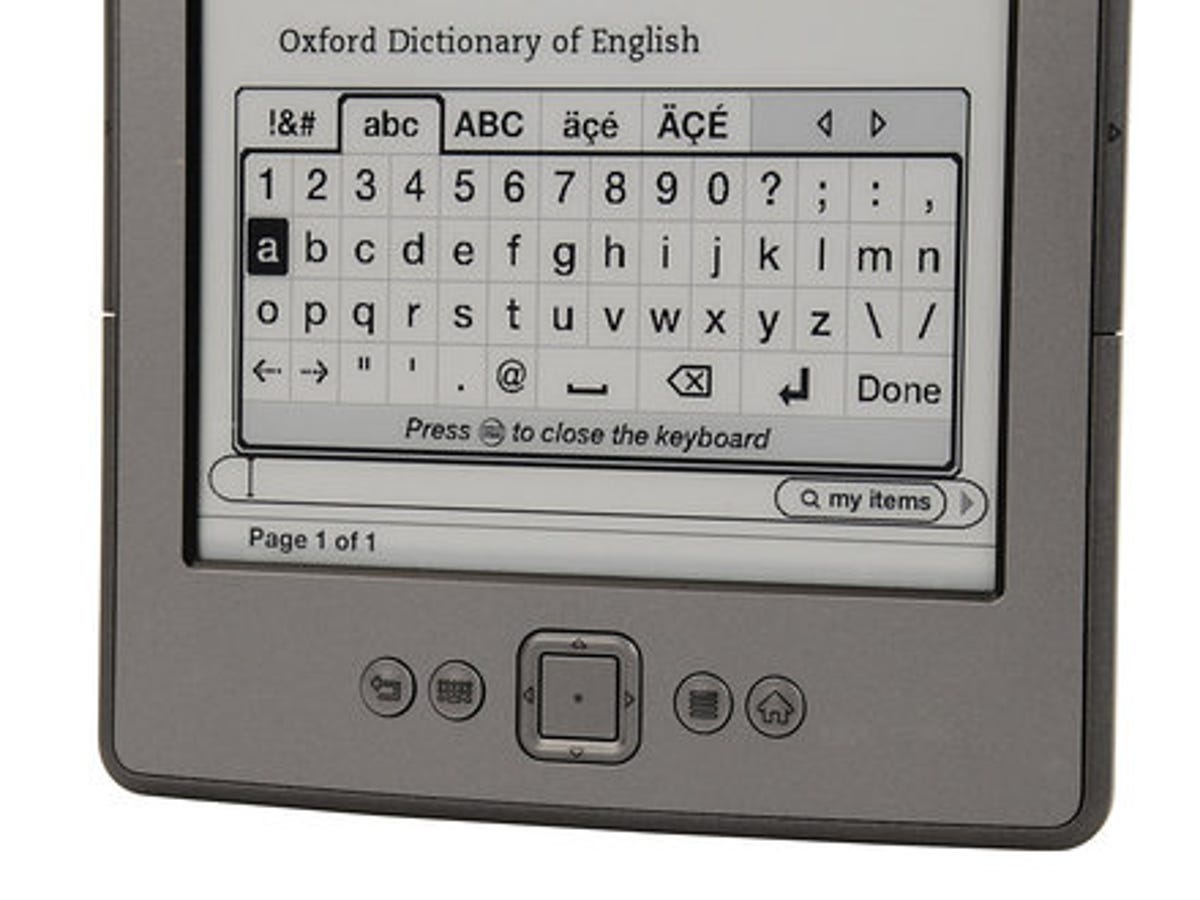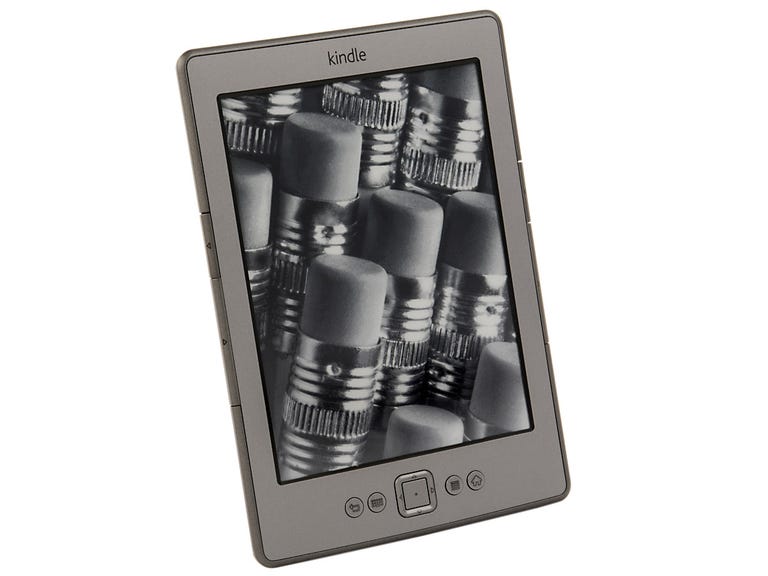 Why You Can Trust CNET
Why You Can Trust CNET Amazon Kindle review: Amazon Kindle
Amazon has slimmed down the Kindle to make it even more affordable, without cutting too many corners. It's a bargain that will let you enjoy the best ebook ecosystem around.
Amazon has reinvented the Kindle yet again, cutting the weight, size, features and, crucially, cost of its ebook reader. At £89, it's the cheapest Kindle ever, turning what was once an indulgence into a pocket-money proposition. It will ship in the UK on 12 October, but we tested the very similar US version, which is available now.
The Good
The Bad
The Bottom Line
Kindle vs books
If the Kindle keeps shrinking like this, it'll soon be the size of a book of stamps. The new entry-level model is 30 per cent lighter and 18 per cent smaller than its predecessor. It now takes up less room in your bag than the slimmest paperback and weighs about half as much.
Incidentally, Amazon has also taken an axe to the device's name. This Kindle, version four by our count, is once again called simply Kindle, with the previous model being renamed the Kindle Keyboard. That's great for branding purposes, but there will inevitably be confusion when you come to buy cases, accessories or second-hand devices.

The space and size savings are largely down to Amazon getting rid of the physical keyboard. In its place are four buttons and a five-way navigation pad. There are large page-forward and small page-back rockers on either side of the Kindle, and a recessed power button on the bottom, next to the micro-USB port. Amazon's cost-cutting hits here -- you only get a USB cable for charging, with a UK adaptor costing an extra £8.50.
Despite its low price and slightly plasticky buttons, the Kindle is solidly built. There isn't a hint of flex in the grey plastic housing and the 6-inch, 600x800-pixel E-Ink display is identical to those on its pricier siblings. Consequently, text looks beautifully solid and dark, page turns are rapid, and greyscale renderings of graphics, banners and photos are acceptable, if never brilliant.
Interface
We tested the Special Offers version of the Kindle. It's 25 per cent cheaper, but you have to put up with sponsored screensavers and a small banner ad on the home screen. When this option eventually appears in the UK, we recommend snapping it up. Not only are the adverts unobtrusive, they're also geo-located for relevance, and often contain attractive offers along the Groupon model of pre-paying for discount vouchers and coupons.
The Kindle wakes up from the screensaver or being fully turned off in under 2 seconds. The home screen is identical to that of previous Kindles. There's a list of recent items, sorted in the order in which you last used them. On the left side, you might see a little icon saying 'new' or 'PDF'. You can sort publications by title, author, most recently acquired, or user-defined categories (called Collections). There's also a link through to older, archived items.
The text-heavy home screen is easy enough to use but pales in comparison to the beautiful virtual bookshelves in Apple's iBooks app for the iPad, or even Amazon's Kindle app for smart phones.
You can visit the Kindle Store by hitting the menu button, which is also used for creating Collections and tweaking settings, including the font size and screen orientation. The Store is unchanged from previous incarnations, with plenty of bestseller lists and a few grainy thumbnails of suggested reads.
Most navigation and selection is handled via the five-way pad, which is fast and responsive but feels painfully cheap. With Amazon having no plans yet to sell its new Kindle Touch devices, or the Kindle Fire tablet, in the UK, you'll have to console yourself with Amazon's boast that the navigation pad at least means 'no on-screen fingerprints'.
There's also a 'back' button that takes you back one step in whatever menu you're using.
Ebooks
The new Kindle has just 2GB of on-board memory and no memory-card slots. That sounds stingy, but it's actually plenty of room. 2GB equates to around 1,400 full-length books, and Amazon also commits itself to storing all of your Amazon purchases in the cloud, for free, forever.
Since you're locked into Amazon's proprietary AZW format -- there's no ePub support here -- the only way to really fill up your Kindle is by loading up audio books or PDF files. The latter generally display fairly well, although navigating them is slow and clunky. Each Kindle has a dedicated email address to which you can send PDFs.
If you stick with the Kindle Store for content, you shouldn't have any problems. Books download over Wi-Fi in seconds, rather than minutes, and display beautifully, including real page numbers on newer titles. The reading experience is smooth and simple, with pages turning much more quickly than on Amazon's original reader. The current Kindle's size is just about right -- large enough to grasp like a book but small enough to hold for hours at a time, without accidentally bashing buttons too often.
As with previous Kindles, everything you do is synced with the cloud via Whispersync. No matter which Kindle device or app you're using, all your content is up to date, including bookmarks and highlights, and you can always pick up from the very last page you read.
Sadly, there's no sign here of the new X-Ray feature that Amazon big cheese Jeff Bezos teased us with last week. X-Ray lets you search a dictionary for the meaning of a word, and search Wikipedia entries for stuff the book refers to. Instead of supporting X-Ray, the new Kindle lets you use the nav pad to position the cursor by a word, making a dictionary definition automatically pop up. Hit the nav pad to select the word and you can see a full definition, or add a note or highlight.
Keyboard
The disappearance of the physical Qwerty keyboard is one of the few sour notes. Now you have to use a soft keyboard for everything from entering Wi-Fi security keys and searching for books to inputting text queries and using the browser. The keyboard is activated by pressing a dedicated button.
The soft keyboard is as good as it can be, but it still feels too much like trying to use a remote control to browse the Web on your TV. It's even worse when using the browser -- if you can get through more than a simple Facebook status update without fishing out your phone or a real tablet, you're far more patient than us.
The other major feature change is the lack of any 3G connectivity. Wi-Fi is great for use around the home and some Internet cafes but free wireless is far from ubiquitous in the UK.
Browser
The main non-reading feature you might want to use is the 'experimental' browser. This isn't the super-duper cloud-accelerated browser that the Kindle Fire tablet will use, but basic HTML software that tries its best to show hi-tech websites on the Kindle's low-res display.
The effect is similar to that of putting your favourite sites through a potato masher and then trying to reconstitute them on the other end. Text loses formatting and sizing, images float all over the place and columns and tables get painfully stretched out. Unlike mashed potato, however, this browser is not helped by the liberal application of tomato ketchup.
When a page first loads, you can move around a window to choose an area to zoom into. This was the only time during our tests that the Kindle showed any sluggishness or lag. Overall, the browser is usable -- just -- but almost any other wireless gadget you have at home is likely to do a better job of surfing the Net. Frankly, without a 3G link, it's hard to see the point of the browser.
British Kindlers lose out again when it comes to other exciting extras. American users get Kindle Active Content: free mini-apps and games, such as poker and Scrabble knock-offs, to while away minutes between newspapers and books. Many can also borrow ebooks for free from over 11,000 public libraries in the US. We tested this feature in Seattle and managed to download a book, for a three-week loan, in a matter of minutes.
Amazon claims the new Kindle has a battery life of around a month. While we haven't had the Kindle long enough to verify this, we had no difficulties with the battery during our test.
Conclusion
The new Amazon Kindle is light, nimble and amazing value for money. No other device can touch it when it comes to the simplicity of buying and reading books. The gains in portability make up for losing the keyboard, especially as the larger Qwerty Kindles are still available.
British book-lovers should feel rightfully miffed at Amazon's tardiness in providing the little extras that would have made the Kindle an absolute must-have, though -- free Wi-Fi hotspots, free mini-apps and Special Offers support. Bolt these on and the new Kindle would be right in line for our coveted five-star Editors' Choice award.
Edited by Charles Kloet
